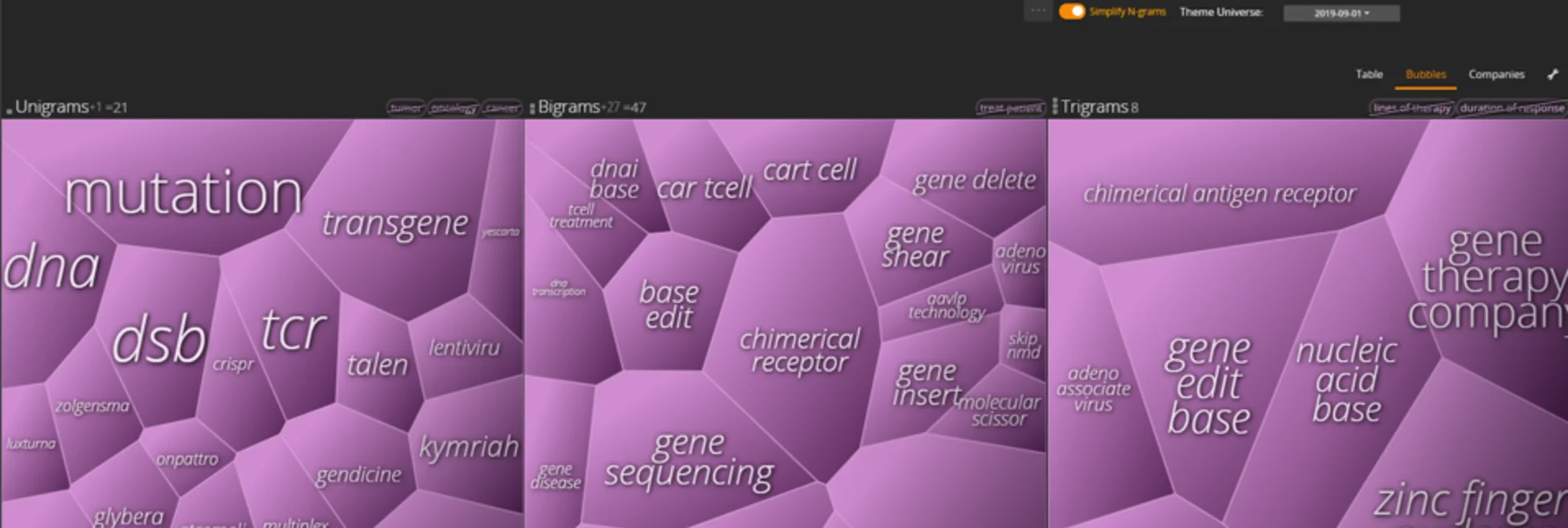
JP Morgan AM develops AI quant tool that uses mind maps to build thematic funds
ThemeBot uses textual relevance and revenue attribution to construct a list of stocks, which is then verified by JPMAM’s active equity analysts.
JP Morgan Asset Management is using an artificial intelligence tool to help its internal portfolio managers and analysts build thematic funds.
The tool, called ThemeBot, was created to help JPMAM’s portfolio managers generate a list of stocks associated with a theme. For example, it was used to construct JPMAM’s Genetic Therapies Fund, which aims to provide diversified exposure to companies in developed and emerging markets working on genetic treatments to address the underlying cause of
Only users who have a paid subscription or are part of a corporate subscription are able to print or copy content.
To access these options, along with all other subscription benefits, please contact info@waterstechnology.com or view our subscription options here: http://subscriptions.waterstechnology.com/subscribe
You are currently unable to print this content. Please contact info@waterstechnology.com to find out more.
You are currently unable to copy this content. Please contact info@waterstechnology.com to find out more.
Copyright Infopro Digital Limited. All rights reserved.
As outlined in our terms and conditions, https://www.infopro-digital.com/terms-and-conditions/subscriptions/ (point 2.4), printing is limited to a single copy.
If you would like to purchase additional rights please email info@waterstechnology.com
Copyright Infopro Digital Limited. All rights reserved.
You may share this content using our article tools. As outlined in our terms and conditions, https://www.infopro-digital.com/terms-and-conditions/subscriptions/ (clause 2.4), an Authorised User may only make one copy of the materials for their own personal use. You must also comply with the restrictions in clause 2.5.
If you would like to purchase additional rights please email info@waterstechnology.com
More on Data Management
Opra considers ‘dynamic load balancing’ for options market
The data distributor recently completed a challenging project to build a 96-line feed. This new endeavor could prove just as challenging (but perhaps necessary) for the industry that will use it.
Market data for private markets? BlackRock sees its big opportunity
The investment giant’s CEO said he envisions a far bigger private market business in 2025.
Bloomberg debuts GenAI news summaries
The AI-generated summaries will allow financial professionals to consume more data, faster, officials say.
Substantive Research reveals new metrics for market data negotiations framework
The research firm will make its industry-derived project available for public consumption next month.
As the ETF market grows, firms must tackle existing data complexities
Finding reliable reference data is becoming a bigger concern for investors as the ETF market continues to balloon. This led to Big xyt to partner with Trackinsight.
Artificial intelligence, like a CDO, needs to learn from its mistakes
The IMD Wrap: The value of good data professionals isn’t how many things they’ve got right, says Max Bowie, but how many things they got wrong and then fixed.
An inside look: How AI powered innovation in the capital markets in 2024
From generative AI and machine learning to more classical forms of AI, banks, asset managers, exchanges, and vendors looked to large language models, co-pilots, and other tools to drive analytics.
As US options market continued its inexorable climb, ‘plumbing’ issues persisted
Capacity concerns have lingered in the options market, but progress was made in 2024.








